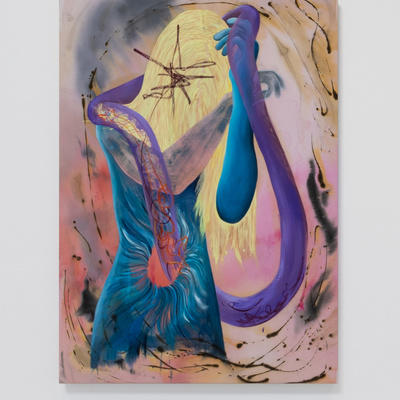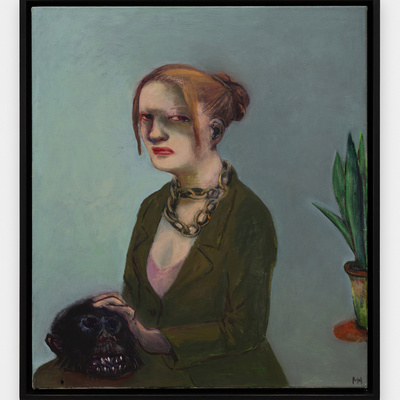
By Her Hand
Artists:
Nora Berman
Star Feliz
Marcelle Hanselaar
Sylvia Maier
Jamilla Okubo
Billie Q
Susana Wald
Uemura Shōen (1875-1949)
Hans Jordaens II (1581-1653)
Anthony Van Dyck (attr.) (1599 - 1641)
Tsukioka Yoshitoshi (1839-1932)
Babst Gallery is pleased to present By Her Hand, an exhibition that includes work by seven contemporary artists who portray moments of violent reclamation, both literal and symbolic. Shown in conjunction are works from the 17th and 19th century that portray women performing harrowing acts of vengeance. Spanning centuries and a range of media, the works in the exhibition speak to self-determination and the unshakable belief in shaping something new.
“Inspired by the Judith heroine myth, I created my own torn narrative, made out of nightmares, fantasies and bodies that long, scar, rest and rage. Nothing has happened. Yet. Nothing is happening. Just now. A flash of a false memory. An image thought to be forgotten. A suppressed anger entering the room.”
—Billie Q
“I wanted to convey Black women's rage, and a Black woman occupying a Eurocentric space. This piece symbolically explores revisioning the history of Black people and the role Black women play in it. The story of colonizers wiping out entire diasporic communities is an all-too-common trope that I wanted to explore and revise.”
—Jamilla Okubo
“My idea for Trophy Wife came from a painting by Cranach who painted Judith, looking sideways with a sardonic glance, when dressed in all her finery, she delicately yet possessively lays a victorious hand on Holofernes cut-off head. Likewise, Trophy Wife is a portrait of a woman in control, well-dressed and coiffed, who sits in full composure knowing that she has won this battle.”
—Marcelle Hanselaar
“In the aftermath of violence, I’ve sifted through the rubble looking for clues and remains of what was. How do I then find balance in protecting this corporal vessel with armor while still remaining open to connection that’s so vital to my humanity? With this work, among other things, I drew upon the mythical and historical influence of feminine warriors and prophetesses to show us that rage and destruction are necessary in order to build anew. The land that birthed me continues to teach me about these rebirth cycles too, so I’m reconstructing these memories with materials from the earth that spark our resourceful legacy in folk-healing innovations.”
—Star Feliz
"I placed the machete in the mise en scène that I created. As it occurred to me to paint the drapery in red… I was led to think about the Judith and Holofernes story. I cannot tell why; in any case, I thought that Holofernes could well have had a premonition of the manner of his death…I only now understand that the egg series is about emergence, the emergence of female energy that has been suppressed for so long."
—Susana Wald
“Images such as those from Pompeii's Villa dei Misteri…and influences such as African drummers circle paintings and studies of African dance provided a powerful vehicle for storytelling….I chose to eschew graphic violence in favor of more nuanced imagery. The red cloth draped over the figures came to represent the sacrifice and struggle for justice and liberation, redirecting the viewer's focus to themes of empowerment and resilience.”
—Sylvia Maier
“I believe Judith’s Beheading Holofernes is a metaphor of the soul’s entrapment in the physical body, and limits of the intellect. I don’t think the motif is so powerful because of what it directly references in history, but it takes a historical moment that is the pinnacle of a universal experience: one person taking a quantum leap to change the fate of mankind.”
—Nora Berman
Nora Berman is a Los Angeles based artist whose works engage with notions of primal consciousness informed by the Dark Web, conspiracy theory, religious hysteria, ecstatic lifestyle cults, paranoia, neurasthenic self-help, violence, and saturation media. She received a BFA from UCLA in 2013 and a MFA from Kunst Institute Basel in 2018. Her work has been shown at the Irish Museum of Modern Art, Dublin; Kunstmuseum St. Gallen; Kunsthaus Basel; Marta Herford Museum, Herford, Germany; dèpendance, Brussels, amongst others.
Star Feliz is a Dominican-American installation artist originally from New York, NY, and is currently based in Los Angeles. Feliz is also the plant spirit medicine healer and founder behind Botánica Cimarrón. In their multidisciplinary practice, earth connection becomes the key to transforming the ruling tenant of colonial doctrines: disconnect people from their land and you disconnect them from their power. Feliz has performed and exhibited nationally and internationally including The Kitchen, New York; The Oregon Contemporary, Portland, OR; The Horse Hospital, London, UK; the Los Angeles Nomadic Division, Los Angeles, amongst others. They have been awarded numerous fellowships, residencies, and grants including Mohn LAND Grant, Los Angeles, CA; and the Printed Matter Emerging Artist Publication Grant, New York. They are a graduate of the MFA program at UCLA’s department of Interdisciplinary Studio.
Marcelle Hanselaar is London-based artist born in Rotterdam, who briefly studied at the Royal Academy of Arts in the Hague, but is primarily self-taught. As an artist, Hanselaar looks for ways to express those elusive questions of who and what we are when the mask is off, and how we appear when the mask is on. Hanselaar has exhibited her paintings and prints internationally, and can be found in private and public collections worldwide, including The British Museum, The Metropolitan Museum of Art, The Victoria & Albert Museum, Oxford; Fitzwilliam Museum, Cambridge; The Swarthmore College Collection, Pennsylvania; The University of Arizona Collection, Tucson; The Sakimi Art Museum, Okinawa; The Guandong Fine Art Museum, China; The Iraq National Library, Baghdad; The Meermanno Museum-House of the Book, The Hague, amongst others.
Sylvia Maier is lifelong New Yorker. As a child, she split her time between New York and Argentina. Her paintings portray her Brooklyn friends—fellow artists, activists, and dancers—in compositions that recall Classical European paintings, such as Ribera and de Chavannes. Her paintings’ palettes recall the color palette of the African Diaspora. Maier attended the School of Visual Art and she is a recipient of the Greenshield Award. Her paintings have been shown at the Parrish Museum in South Hampton, The Corridor at Lincoln Center, amongst others.
Jamilla Okubo was born in North Carolina and lives and works in Washington, D.C. Okubo is an interdisciplinary artist exploring the intricacies of belonging to an American, Kenyan, and Trinidadian identity. Okubo's patterns are influenced by kanga cloth, transmit messages rooted in Swahili proverbs, excerpts from the Qur’an, African folklore, and popular culture. Okubo has participated in various group exhibitions, most recently at The House of Fine Arts in London and The Southampton Arts Center in Southampton, NY. She has created art installations for Culture Corp x Hudson Yards, New York, and the Line Hotel.
Billie Q lives and works in Antwerp, Belgium, and has worked primarily with photography and video, but recently started to work in textile and ceramic sculpture. Billie Q is intrigued by heroine myths, and in her photographs and videos, she often embodies these female icons and restages their story. Other times, she photographs people she knows to tell the story her own way. In 2022, Billie completed her Master's Degree in Fine Arts at Sint Lucas Antwerp. She has exhibited widely, in Antwerp, including the Antwerp Queer Arts Festival, To Be Antwerp, Art Telex, and the Museum of Contemporary Art in Antwerp.
Susana Wald was born in Budapest, and has lived in Mexico since 1994. Wald has been creating work for over 60 years in Argentina, Chile, and Canada; she currently works in her studio in Santo Andrés Huaygapan, in the surroundings of the city of Oaxaca. From 1972-2002, she worked on a series of paintings that portrayed the egg as the central motif. A key figure of the Surrealist Movement, she has participated in numerous group exhibitions, including the XLII Venice Biennale in 1986, and the Iberoamerica Pinta traveling exhibition, organized by UNESCO, which visited 18 countries from 1997 to 2000. In 2021, her retrospective En busca de lo Inasible was shown at at Museo Nacional de Bellas Artes, Santiago, Chile.
Uemura Shōen (1875 – 1949) was the pseudonym Uemura Tsune, who was born in Kyoto in 1875. She was one of the few printmakers and painters of the Taisho era to gain critical and popular success. She was the first female recipient of the Order of Culture, and was hired as the imperial Household’s official Artist. Her work was included in the supplements to “Dai-Chikamatsu Zenshu,” which included 18 color woodblock prints from original paintings by popular artists at the time. In this series, she depicts the character from Chikamatsu’s play, the ghost of a woman who was led into the forest and murdered. She manifests as the Yuki Onna, the Snow Woman, to get her revenge.
Hans Jordaens II (1581-1653) was a member of the Gilde de St. Luc in Antwerp in 1600. His son and pupil was Hans Jordaens III who married Maria van Dyck. His work can be found in the Royal Gallery at Dresden, the Hermitage Museum of St. Petersburg, Hampton Court, the Musee Royal de Tableaux in Mauritius, and the National Gallery in London.
Anthony van Dyck (1599-1641) was a Flemish painter who was one of the most important and prolific painters of the 17th century. At the age of ten, he was registered with the city's Guild of St. Luke as an apprentice under Hendrick van Balen and by 1618 he was working in Peter Paul Rubens' workshop. In 1621 he traveled to Italy, where he produced works for private and public collections in Genoa, Rome and Palermo. In 1627 he returned to Antwerp and in 1632 became the Chief Painter to King Charles I and his wife Henrietta Maria. At Charles I’s Court, he received a number of commissions from Catholic patrons, including Kenelm Digby. According to Giovanni Pietro Bellori in 1672, Digby commissioned van Dyck to do a series of religious paintings, including Judith with the Head of Holofernes.
Tsukioka Yoshitoshi (1839-1892) was born as Owariya Yonejiro in Edo, Japan. At 11, he was apprenticed to printmaker Utagawa Kuniyoshi, whose studio specialized in depictions of heroic battle scenes. Yoshitoshi was the last great master of the Ukiyo-e genre of woodblock printing. Yoshitoshi's 1874 series, “Biographies of Valiant Drunken Tigers," illustrates warriors during the civil wars leading to the restoration of the Meiji Emperor.
Tsukioka Yoshitoshi, Uji no Saijo (Watanabe's Wife) from the Series Biographies of Valiant Drunken Tigers, 1874. Woodblock print, ink and color on paper. 15 1/2 x 10 1/2 inches.
Jamilla Okubo, Medicine for a Nightmare (Judith and Holofernes). 2021. Acrylic and mixed media on canvas. 60 × 48 inches
Billie Q, Judith #1, 2018. Matte prints of negatives, mounted on MDF. 6 2/3 x 8 1/3 inches. Edition of 2.
Marcelle Hanselaar, Vindication, Judith and Holofernes, 2022. Etching, aquatint. 14.9 x 16.9 inches. Edition of 30.
Billie Q, Judith #10, 2018. Matte prints of negatives, mounted on MDF. 6 2/3 x 8 1/3 inches. Edition of 2.
Nora Berman, X girl Pierced O (mountain scape gape face) I, 2016. Oil on muslin. 90 1/2 x 65 x 1/2 inches.
Star Feliz, Seventh Direction Six, 2023. Cement mortar, soil, sand, pigment, insulation foam, bay leaves (umbellularia californica). 33 x 28 x 7 inches.
Billie Q, Judith #2, 2018. Matte prints of negatives, mounted on MDF. 6 2/3 x 8 1/3 inches. Edition of 2.
Marcelle Hanselaar, The Split, Adam and Eve, 2022. Etching, aquatint. 14.9 x 16.9 inches. Edition of 30.
Billie Q, Judith #14, 2019. Matte prints of negatives, mounted on MDF. 6 2/3 x 8 1/3 inches. Edition of 2.
Hans Jordaens The Younger, Judith and her Maid with the Head of Holofernes, 1610-1630. Oil on panel. 18 1/9 x 26 1/2 inches.
Marcelle Hanselaar, Beauty and the Beasts, Salome, 2022. Etching, aquatint. 14.9 x 16.9 inches. Edition of 30.
























